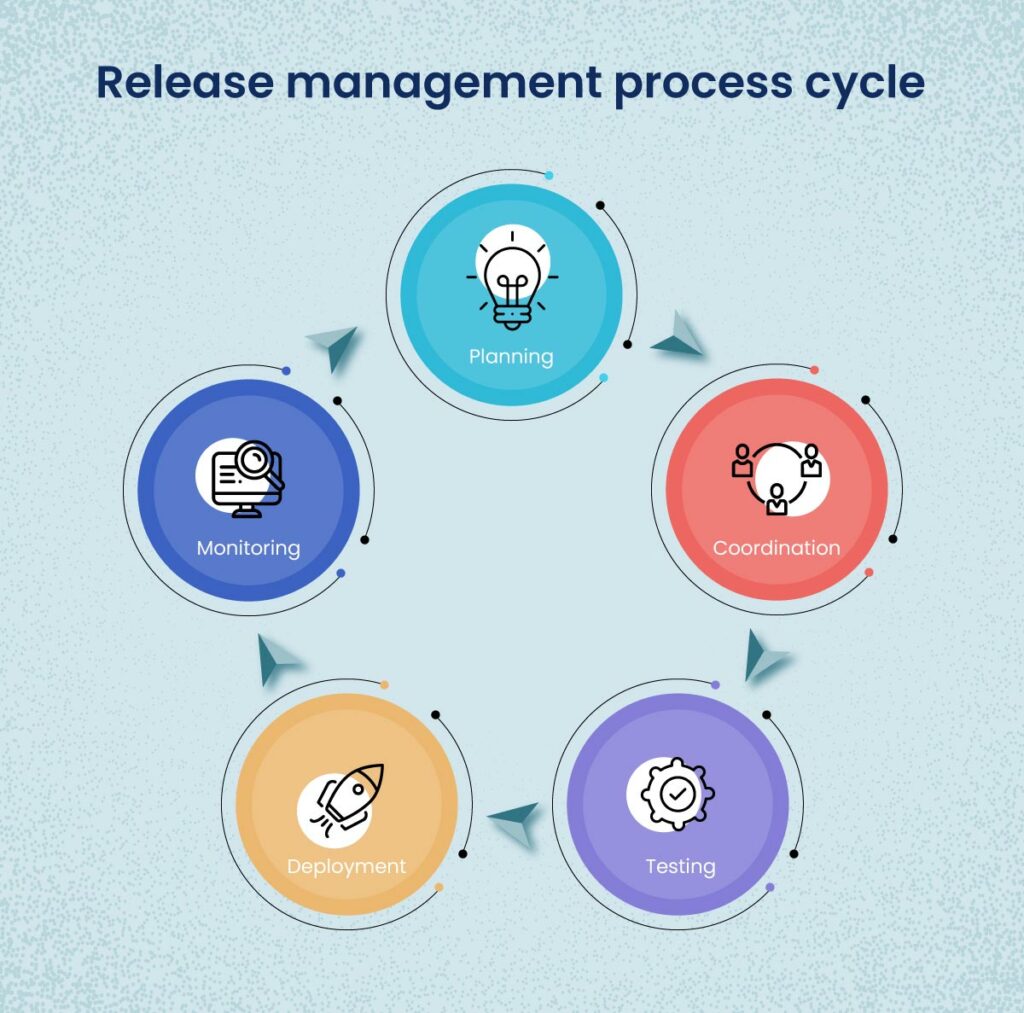In today’s constantly evolving business landscape, the ability to deliver high-quality software quickly and efficiently has become critical for success. A well-defined and efficient release management process is essential to ensure that software products are released to market smoothly and without any significant issues.
However, creating a successful release management process is no easy feat. It requires a comprehensive approach that involves planning, coordination, and collaboration between different teams and stakeholders.
In this blog, we will discuss the five key steps to building a successful release management process that can help organizations deliver high-quality software faster and more efficiently while minimizing risks and costs.
From planning and coordination to testing and deployment, we will explore the essential components of a robust release management process that can help organizations stay ahead in today’s competitive landscape.
What is release management?
Release management is the process of planning, coordinating, and overseeing the software release cycle to ensure that software products are delivered to customers or end-users efficiently and effectively. It involves managing the various stages of the software development lifecycle, from planning and development to testing, deployment, and post-release support.
Release management is critical for ensuring that software products are released to market smoothly and without any significant issues, which can affect user experience, reputation, and revenue. A well-defined and efficient release management process helps organizations to deliver high-quality software faster and more efficiently while minimizing risks and costs.
Release management typically involves collaboration between different teams and stakeholders, including developers, quality assurance (QA) testers, operations teams, project managers, and business stakeholders. The release management process varies depending on the organization, the software product, and the release cycle, but it typically includes activities such as planning, tracking, communication, testing, deployment, and monitoring.
5 steps to release management
Here are the five key steps to a successful release management process:

- Planning: The planning stage is critical for setting the foundation of a successful release. This involves defining the scope of the release, identifying dependencies and potential risks, setting timelines, and establishing clear communication channels between different teams and stakeholders. A well-defined release plan helps to ensure that everyone is on the same page and has a clear understanding of what needs to be done to achieve a successful release.
- Coordination: Once the release plan is in place, the coordination phase begins. This involves ensuring that all teams and stakeholders involved in the release are aligned and working together to achieve the common goal. Effective coordination requires regular communication, collaboration, and transparency to keep everyone informed and engaged throughout the release cycle.
- Testing: The testing phase involves ensuring that the software product is thoroughly tested and validated before release. This includes functional and non-functional testing, as well as user acceptance testing (UAT) to ensure that the software product meets the needs and expectations of end-users. Testing should be automated as much as possible to reduce the risk of human error and ensure consistency.
- Deployment: Once testing is complete, the deployment phase begins. This involves deploying the software product to the production environment while ensuring that all dependencies and configurations are properly managed. It is essential to have a rollback plan in place in case of any issues or errors during deployment.
- Monitoring: The final stage of the release management process is monitoring. This involves tracking and monitoring the software product in the production environment to ensure that it is functioning as intended and to identify and address any issues or bugs. Monitoring also involves collecting feedback from end-users and stakeholders to inform future releases and improvements.
By following these five key steps, organizations can establish a robust and efficient release management process that helps to ensure successful software releases while minimizing risks and costs.
Release management vs. change management
Release management and change management are related but distinct processes in software development.
Release management is the process of planning, coordinating, and overseeing the software release cycle to ensure that software products are delivered to customers or end-users efficiently and effectively. It involves managing the various stages of the software development lifecycle, from planning and development to testing, deployment, and post-release support.
Change management, on the other hand, is the process of controlling and managing changes to the software environment or infrastructure, including hardware, software, and processes. Change management is focused on ensuring that changes to the software environment are implemented in a controlled and structured way to minimize the impact on the organization and to maintain stability, reliability, and security.
While release management and change management share some similarities, they have different objectives and processes. Release management is focused on the release of software products, while change management is focused on managing changes to the software environment. However, they are both critical processes for ensuring the successful and efficient delivery of high-quality software products, and they often work closely together to achieve these goals.
Release management methods
There are several release management methods that organizations can use to ensure the successful and efficient delivery of high-quality software products.
Here are a few examples:

- Continuous Delivery: Continuous Delivery is an approach to software development and release that emphasizes the frequent and regular delivery of working software to customers or end-users. It involves automating the entire software delivery process, from code commit to deployment, testing, and release. The goal of continuous delivery is to reduce lead times, minimize risks, and increase the quality of software products.
- Agile Release Management: Agile Release Management is an approach to software release that is based on the principles of Agile software development. It emphasizes collaboration, flexibility, and rapid feedback to ensure that software products are delivered quickly and efficiently while maintaining high quality. Agile Release Management involves breaking down the software development process into smaller, iterative cycles called sprints, with each sprint delivering a potentially shippable product increment.
- DevOps Release Management: DevOps Release Management is an approach to software release that emphasizes the integration of development and operations teams to ensure the efficient and effective delivery of software products. It involves automating the entire software delivery process, from code commit to deployment, testing, and release, while also ensuring that operations teams are involved throughout the development process to provide input on infrastructure requirements and scalability.
- Waterfall Release Management: Waterfall Release Management is a traditional approach to software release that is based on the Waterfall software development methodology. It involves a linear, sequential process, where each stage of the software development lifecycle is completed before moving on to the next stage. While Waterfall Release Management can be effective for certain types of projects, it can be slower and less flexible than other release management methods.
Ultimately, the choice of release management method depends on the specific needs and goals of the organization and the software product being developed. The key is to choose a method that supports the efficient and effective delivery of high-quality software products while minimizing risks and costs.
Tools for release management
There are many tools available for release management that can help organizations to plan, coordinate, and oversee the software release cycle. Here are a few examples:
- Yoroproject: Yoroproject is a popular project management tool that can also be used for release management. It provides features for tracking tasks, issues, and bugs, as well as tools for managing releases, setting timelines, and tracking progress. Yoroproject can be customized to suit the specific needs of an organization and can integrate with other tools.
- GitHub: GitHub is a popular code repository and collaboration tool that can also be used for release management. It provides features for tracking changes, managing pull requests, and automating the release process. GitHub can also integrate with other tools like Jenkins and CircleCI for continuous integration and deployment.
- Microsoft Azure DevOps: Microsoft Azure DevOps is a comprehensive set of tools for software development, including features for release management. It provides features for managing code, tracking work items, managing builds and releases, and monitoring applications. Azure DevOps can be customized to suit the specific needs of an organization and can integrate with other tools like Jenkins and Docker.
- Jenkins: Jenkins is an open-source automation server that can be used for release management. It provides features for continuous integration and continuous delivery, allowing organizations to automate the entire software delivery process, from code commit to deployment and release. Jenkins can be customized with plugins to support specific tools and processes.
- Octopus Deploy: Octopus Deploy is a release management tool that provides features for managing the entire software delivery process, including deployment, configuration management, and release orchestration. It allows organizations to automate the entire release process, from testing to deployment and post-release monitoring.
These are just a few examples of the many work management tools available for release management. The key is to choose a right project management tool that supports the specific needs and goals of the organization and integrates well with other tools and processes in the software development lifecycle.




